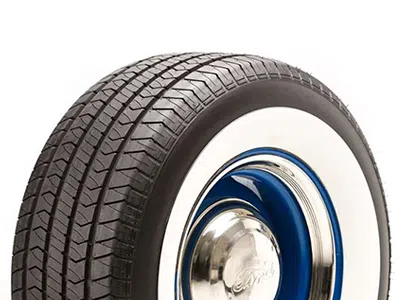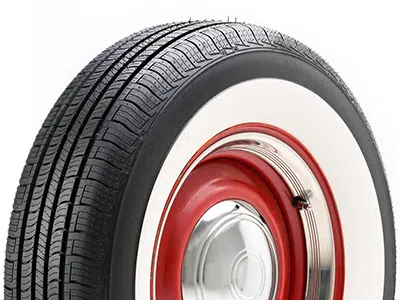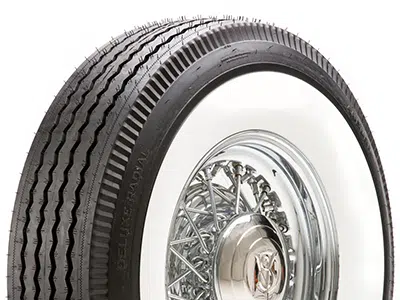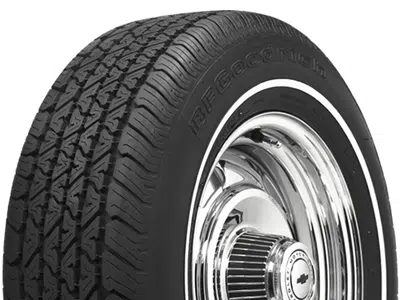Understanding Whitewall Tire Styles
The world of whitewall tires encompasses several distinct styles, each associated with specific eras and applications. Selecting the right style is crucial for achieving an authentic period-correct look or creating your desired custom aesthetic. This comprehensive guide will help you navigate the various options available.

Wide Whitewalls (3-4 inches)
Era: 1930s-1940s
Best for: Pre-war classics, early 1940s luxury vehicles, authentic museum-quality restorations
Characteristics: Substantial white band creating dramatic contrast, period-correct for pre-WWII vehicles through early post-war luxury models

Medium Whitewalls (2-3 inches)
Era: Early to mid-1950s
Best for: Early 1950s classics, period-correct restorations of mid-century automobiles
Characteristics: Balanced white band that complements the flowing designs of 1950s vehicles without overwhelming the wheel profile

Narrow Whitewalls (1-2 inches)
Era: Late 1950s-1960s
Best for: Late 50s and 60s classics, muscle cars, premium vehicles of the era
Characteristics: More subtle white band that pairs well with the cleaner, more modern styling of later 1950s and 1960s vehicles

Pinstripe Whitewalls (under 1 inch)
Era: 1970s-early 1980s
Best for: 1970s luxury vehicles, later muscle cars, subtle custom applications
Characteristics: Thin white line providing a refined accent without the bold contrast of wider styles
Selecting the Right Size for Your Application
Beyond style considerations, proper sizing is critical when selecting whitewall tires. Correct fitment ensures both authentic appearance and safe performance. White wall tires are available in several sizing systems depending on the era and application of your vehicle.
Understanding Tire Sizing Systems
Vintage/Antique Sizing (Pre-1950s)
Early vehicles typically used sizing nomenclature that directly referenced the nominal dimensions of the tire, such as 6.00-16 or 7.50-17. In these examples:
- The first number (6.00 or 7.50) represents the approximate width of the tire in inches
- The second number (16 or 17) indicates the wheel diameter in inches
These vintage sizes are still used for authentic restorations of pre-1950s vehicles, with whitewall widths typically between 2.5-4 inches for period correctness.
Classic Sizing (1950s-1970s)
Mid-century vehicles often used similar dimensional sizing but with evolving standards. Examples include 8.20-15 or E78-14, where:
- In numeric designations (8.20-15), the first number represents width and the second is wheel diameter
- In alpha-numeric designations (E78-14), the letter indicates the tire's width category, the number after it relates to aspect ratio, and the final number is wheel diameter
White wall widths during this era progressively narrowed from about 3 inches in the early 1950s to narrow 1-inch bands and pinstripes by the late 1960s and 1970s.
Modern Metric Sizing (1970s-Present)
Contemporary vehicles use metric sizing such as P215/75R15, where:
- P indicates Passenger vehicle tire
- 215 is the width in millimeters
- 75 is the aspect ratio (height as a percentage of width)
- R designates Radial construction
- 15 is the wheel diameter in inches
Modern reproductions of whitewall tires often use this sizing system while maintaining traditional whitewall aesthetics, typically offering narrow bands or pinstripes for compatibility with contemporary vehicles.
Period-Correct Sizing Guide by Vehicle Era
| Vehicle Era | Common Tire Sizes | Typical Whitewall Width | Notes |
|---|---|---|---|
| 1930s-Early 1940s | 6.00-16, 7.00-16, 7.50-17 | 3-4 inches | Wide whites dominate this era, particularly on luxury vehicles |
| Late 1940s-Early 1950s | 7.60-15, 8.00-15, 6.70-15 | 2.5-3.5 inches | Post-war transition period with still-substantial whitewalls |
| Mid-1950s | 7.50-14, 8.00-14, 7.10-15 | 2-3 inches | Medium whitewalls become standard as styling modernizes |
| Late 1950s-Early 1960s | 8.00-14, 8.50-14, 7.50-15 | 1-2 inches | Narrower bands complement the cleaner styling of this period |
| Mid-1960s-1970s | E78-14, F70-14, G70-15 | 0.5-1 inch | Narrow bands and pinstripes become predominant |
| 1970s-1980s | P195/75R14, P215/75R15 | 3/8-1/2 inch (pinstripe) | Pinstripes remain on some luxury models as whitewalls fade from common use |
Historical Accuracy Note:
When pursuing an authentic restoration, research your specific vehicle model and year using original marketing materials, owner's manuals, or marque-specific reference guides. Factory options sometimes included different whitewall widths or styles even within the same model year.
Construction Types and Performance Considerations
Beyond appearance, understanding different whitewall tire construction methods helps you select the best option for your specific needs and driving habits.
Bias-Ply Whitewalls
Construction: Multiple layers of rubber-coated fabric cords arranged diagonally across the tire
Best for: Authentic historical accuracy in restorations, especially pre-1970s vehicles
Advantages:
- Period-correct appearance and driving characteristics
- Authentic sidewall profile and stance
- Traditional manufacturing methods align with original specifications
Considerations:
- Less precise handling compared to modern designs
- Shorter tread life than radial construction
- Higher rolling resistance affecting fuel economy
- May track in road irregularities more noticeably
Radial Whitewalls
Construction: Fabric cords arranged at 90° to the direction of travel with stabilizing belts beneath the tread
Best for: Vehicles driven regularly, restorations where modern performance is desired
Advantages:
- Superior handling and stability
- Extended tread life
- Improved fuel efficiency
- Enhanced wet-weather performance
- Modern construction with vintage appearance
Considerations:
- Different ride characteristics than original bias-ply tires
- May alter the stance or appearance slightly on some vehicles
- Not period-correct for pre-1970s vehicles (radials became common in the 1970s)
Bias-Belted Whitewalls
Construction: Bias-ply construction with stabilizing belts added beneath the tread
Best for: Compromise between authenticity and improved performance
Advantages:
- More period-correct appearance than radials for 1960s-early 1970s vehicles
- Better performance than traditional bias-ply construction
- Historically accurate for the transitional period before radials became standard
Considerations:
- Less common in modern reproduction tires
- Still lacks the performance benefits of full radial construction
- Represents a specific transitional technology from the late 1960s-early 1970s
Special Applications and Considerations
Custom and Modified Vehicles
For custom builds and modified classics, whitewall tires offer distinctive styling options beyond strictly period-correct applications. Consider these popular approaches:
- Wide White/Modern Wheel Combinations: Pairing wide whitewalls with modern larger-diameter wheels creates a striking juxtaposition that defines certain custom styles, particularly in lowrider and custom culture
- Low-Profile Whitewalls: Contemporary performance tire profiles (lower aspect ratios) with whitewall styling blend modern handling characteristics with classic aesthetics
- Contrasting Whitewalls: Using whitewalls on specific axles (commonly front only or rear only) to create visual emphasis and unique profile views
Modern Vehicles with Retro Styling
Several current production vehicles embrace retro design elements that can be enhanced with appropriate whitewall tires:
- Narrow Band Applications: Subtle pinstripe or narrow whitewalls complement modern vehicles with heritage-inspired styling
- OEM+ Approach: Selecting whitewalls that maintain factory tire specifications while adding period-inspired styling
- Portawall Options: For vehicles where dedicated whitewall tires aren't available in the required sizes, removable portawalls can provide the aesthetic without requiring specialty tires
Trailer and Specialty Applications
White wall tires can extend beyond passenger vehicles to create cohesive presentations:
- Classic Trailers: Period-correct whitewalls on vintage trailers complete the historical presentation when towed by classic vehicles
- Vintage Motorcycles: Many classic motorcycles featured whitewall tires, with specific sizing and narrow white bands typical
- Special Interest Vehicles: Vintage commercial vehicles, period delivery trucks, and classic recreational vehicles often featured whitewalls as premium options
Quality and Brand Considerations
When investing in whitewall tires, quality variations can significantly impact both appearance and performance. Consider these factors when selecting a manufacturer:
Whitewall Definition
Premium manufacturers create crisp, clean lines between the white and black portions of the tire. Lower-quality options may have less defined transitions or irregular whitewall width around the circumference.
White Compound Quality
Superior whitewall tires use compounds specifically formulated to resist yellowing, staining, and discoloration. Quality manufacturers incorporate UV inhibitors and anti-oxidants that maintain the pristine white appearance with proper care.
Construction Consistency
Respected brands maintain tight quality control over sidewall thickness, white layer depth, and overall dimensional stability. This consistency ensures uniform appearance when multiple tires are mounted on a vehicle.
Historical Accuracy
Some manufacturers specialize in reproducing tires with precise historical specifications, including tread patterns, sidewall markings, and construction methods authentic to specific periods. These details matter significantly for concours-level restorations.
Frequently Asked Questions About Whitewall Tires
Research your specific vehicle using original sales brochures, factory documentation, or period photographs. As a general guideline: vehicles from the 1930s-1940s typically used 3-4 inch whitewalls, 1950s models transitioned from 2-3 inch to 1-2 inch widths, 1960s vehicles commonly featured 1-inch styles, and by the 1970s, narrow pinstripes of 1/2 inch or less became standard. For concours-quality restorations, consulting marque-specific historical resources ensures perfect period accuracy.
While technically possible if available in your vehicle's required size, there are important considerations. First, ensure the whitewall tires meet all performance specifications (load rating, speed rating, etc.) required by your vehicle manufacturer. Second, confirm the tire construction type (typically radial for modern vehicles) matches your vehicle's requirements. Narrow whitewalls or pinstripes tend to complement modern vehicles better than wider styles, which may appear disproportionate on contemporary wheel designs.
Bias-ply tires feature diagonal internal ply cords that cross each other, while radial tires have cords arranged at 90 degrees to the direction of travel with stabilizing belts. For whitewalls, this construction difference affects both appearance and performance. Bias-ply whitewalls provide more authentic appearance and ride characteristics for pre-1970s vehicles but offer less traction, shorter tread life, and higher rolling resistance than radials. Radial whitewalls deliver modern handling, longer wear, and better fuel economy while maintaining classic styling.
Yes, maintaining the white portion requires additional care. Regular cleaning with whitewall-specific cleaners prevents staining and yellowing. Avoid petroleum-based tire dressings on the white portions as they can cause discoloration. Store vehicles with whitewalls away from direct sunlight when possible, as UV exposure accelerates yellowing. When cleaning, use soft brushes designed for whitewalls rather than abrasive materials that could damage the surface. Quality whitewall tire covers provide additional protection during extended storage.
Original vintage tires (typically 30+ years old) should be considered display items only, regardless of their apparent condition. Rubber compounds deteriorate over time through oxidation and chemical breakdown, compromising structural integrity even when visible damage isn't present. Modern reproduction whitewalls provide the authentic appearance while incorporating contemporary safety standards and fresh rubber compounds. For vehicles that will be driven, always choose new production tires manufactured within the past few years.